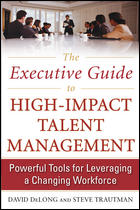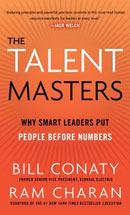Recommended Resource – The Executive Guide to High-Impact Talent Management
The Executive Guide to High-Impact Talent Management: Powerful Tools for Leveraging a Changing Workforce
by David DeLong and Steve Trautman
About the Reference
The Executive Guide to High-Impact Talent Management: Powerful Tools for Leveraging a Changing Workforce by David DeLong and Steve Trautman provides a complete talent management program blueprint covering:
- Diagnosis of talent related organizational risks
- Evaluation and measurement of talent management initiatives
- Acceleration of leadership development
- Transference of individual and organizational knowledge
This blueprint provides the details needed to institute each of these programs and achieve real, measurable results.
Benefits of Using this Reference
StrategyDriven Contributors like The Executive Guide to High-Impact Talent Management because the blueprint provided is implementable, actionable, and based on many of the practices endorsed by StrategyDriven. These practices focus on continuous programmatic assessment and performance measurement to drive superior results. If we had one criticism of the book it would be that the solutions presented appear too academic and unaltered by the realities of the business world.
The Executive Guide to High-Impact Talent Management provides a thorough, implementable talent management program based on sound principles of accountability; making it a StrategyDriven recommended read.


 Today’s fast moving marketplace demands that companies be in an almost constant state of change in order to remain competitive. Subsequently, businesses reorganize, new roles are created, and existing positions eliminated on an almost continuous basis. Throughout these changes, it remains important to keep all organization members well aligned and focused on achieving the company’s mission goals. To do this requires ongoing retranslation of these goals to the day-to-day activities of the workforce. Often overlooked but important to maintaining alignment is the updating of job description documents.
Today’s fast moving marketplace demands that companies be in an almost constant state of change in order to remain competitive. Subsequently, businesses reorganize, new roles are created, and existing positions eliminated on an almost continuous basis. Throughout these changes, it remains important to keep all organization members well aligned and focused on achieving the company’s mission goals. To do this requires ongoing retranslation of these goals to the day-to-day activities of the workforce. Often overlooked but important to maintaining alignment is the updating of job description documents.
 Hank Moore has advised 5,000+ client organizations worldwide (including 100 of the Fortune 500, public sector agencies, small businesses and non-profit organizations). He has advised two U.S. Presidents and spoke at five Economic Summits. He guides companies through growth strategies, visioning, strategic planning, executive leadership development, Futurism and Big Picture issues which profoundly affect the business climate. He conducts company evaluations, creates the big ideas and anchors the enterprise to its next tier. The Business Tree™ is his trademarked approach to growing, strengthening and evolving business, while mastering change. To read Hank’s complete biography,
Hank Moore has advised 5,000+ client organizations worldwide (including 100 of the Fortune 500, public sector agencies, small businesses and non-profit organizations). He has advised two U.S. Presidents and spoke at five Economic Summits. He guides companies through growth strategies, visioning, strategic planning, executive leadership development, Futurism and Big Picture issues which profoundly affect the business climate. He conducts company evaluations, creates the big ideas and anchors the enterprise to its next tier. The Business Tree™ is his trademarked approach to growing, strengthening and evolving business, while mastering change. To read Hank’s complete biography,  Dave Anderson, author of
Dave Anderson, author of